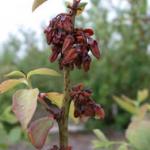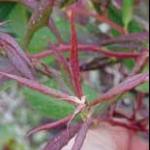Blueberry IPM - Aphids
Blueberry Aphid (Illinoia pepperi)
ID/Life Cycle:
There are several species of aphids that can infest blueberries, but Blueberry Aphid (BA) is the most damaging. This is due to their role in transmitting viruses from infected to uninfected blueberry plants. Blueberry Shoestring Virus and Blueberry Scorch Virus are two viruses of concern in New England that are vectored by this aphid.
Adult BA are small, green, soft-bodied insects and may be winged or wingless. The immature stages (or nymphs) of BA are very similar in appearance to adult aphids but smaller and lack wings. There are several instars of BA nymphs, each gaining in size with each molt. Both adult and nymphal life stages feed on plant sap with piercing and sucking mouthparts. This is how viruses are picked up and transmitted to new plants.
These insects tend to congregate on the underside of leaves, where their feeding causes the leaves to curl downward and be deformed. Feeding also results in the excretion of a sticky substance called ‘honeydew’, that lands on plant surfaces and can lead to the growth of fungi like Sooty Mold.
Aphids overwinter as tiny eggs on blueberry bushes. In spring, young aphids hatch and colonize new leaf growth, living on the undersides of leaves. Populations grow during the summer. There are multiple generations each year.
Damage:
Aphids feed on leaves and succulent new growth. Damage occurs primarily when aphids transmit viruses from infected to non-infected plants. Very little direct damage from feeding occurs.





Management:
Monitoring:
To scout for aphids, examine 2 young shoots on each of 10 bushes randomly in a field and record the number of shoots where aphids are found. Multiply by 5 to get the percentage of infested shoots. It is also a good idea to record the number of shoots with parasitized aphids to get a measurement of the level of biocontrol present in your field. When parasitized by small wasps, aphids die and turn into crusty "mummies" that can be gold or beige in color. A new adult wasp emerges from the parasitized aphid after a few days.
Be sure to sample weekly from as wide an area in the field as possible to have a better chance of detecting whether aphids are present. Mapping ‘hot spots’ can provide a useful record over time and help direct future scouting and management activities.
Treatment thresholds are dependent upon whether or not Scorch or Shoestring Virus is known (or suspected) to be present. Determining that will require virus testing. Check with a diagnostic lab to get help in confirming if virus infection is the cause of symptoms. The UMass Diagnostic Lab sample submission instructions can be found at: http://ag.umass.edu/services/plant-diagnostics-laboratory/tree-fruit-small-fruit-diagnostics.
Where Scorch or Shoestring virus infection in the planting is known or suspected, if 10% of the leaves sampled have more than 5 aphids per leaf, treatment is indicated. Where virus infection in the planting is not present, if 50% of leaves sampled have more than 5 aphids per leaf, then treatment is indicated[1].
Control strategies
Preventive practices:
- Viruses are plant pathogens that can be transmitted by contaminated pruning tools. When pruning, avoid transmitting viruses to other plants by wearing gloves and by sanitizing pruning shears with ethanol or isopropyl alcohol.
Cultural/Biological:
- Avoid excess nitrogen fertilization as this can promote high aphid populations.
- Preserve natural enemies whenever possible by selecting spray materials that are less toxic to beneficial insects like aphid parasitoids.
- Rogue out all plants that exhibit virus symptoms.
Chemical:
- See New England Small Fruit Management Guide for currently recommended spray materials for Blueberry Aphids.
- Apply recommended insecticides when scouting results show populations over the 10% threshold (in fields where virus is known to be present), or over the 50% threshold where virus infection is not present, to avoid transmission of viruses such as blueberry scorch.
- Ensure accurate delivery of spray material by good sprayer calibration and maintenance.
- If repeat spray applications are needed, rotate insecticides from different IRAC groups to reduce the chance of resistance development in the pest.
- DO NOT APPLY INSECTICIDES DURING BLOOM.
Date: February 2020
Additional information available on the MYIPM app: https://apps.bugwood.org/apps/myipmseries/
Note: This information is for educational purposes only and is reviewed regularly for accuracy. References to commercial products or trade names are for the reader’s information. No endorsement is implied, nor is discrimination intended against similar products. For pesticide products please consult product labels for rates, application instructions and safety precautions. The label is the law. Users of these products assume all associated risks.
This work was supported in part by funding provided by USDA NIFA Extension Implementation Program, Award No. 2017-70006-27137
[1] Thresholds derived from Washington State Blueberry IPM Scouting Manual; thresholds for New England may vary slightly. Use this information as a guideline and adjust as needed.